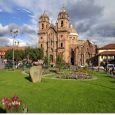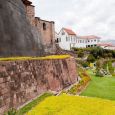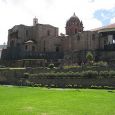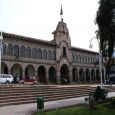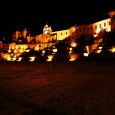Cuzco
Advertisement
By plane
The closest main international airport is Lima. The airport is at the edge of the city (taxi ride). There are daily internal flights to and from Lima, Arequipa and small jungle airstrips in the Amazon basin. Lan Peru has the most flights to/from Cusco and Lima followed by Star Peru and Taca. It is best to book the earlier flights to avoid weather delays and overbooking.
By bus
The Terminal Terrestre is about a 20 minute walk down the Av. Sol. You can also take a taxi for a few soles.Buses are plentiful from other Peruvian cities like Lima (about 24 hours), Puno (6-8 hours), Arequipa (10 hours, 20 soles), Nazca (14-16 hours) etc, but are quite long and slow, although the views can compensate. The main roads are quite good, but some can be bad, making trips take longer than expected.
By rail
Cuzco is connected to Machu Picchu and Puno by rail. Rail service was recently discontinued to Arequipa. This service is operated by PeruRai
Advertisement
Qoricancha
The Sun Temple, was the central site of worship for the Incas. Like so many other testimonies of Inca fantastic architecture it was severely devastated by the conquistadores, the Spanish conquerors, who built their Christian church, Santo Domingo, on top of the ruins. Yet most of the bottom part of the temple is fairly well preserved and makes the site worth several hours of your time, and is one of the best in Cuzco, or Qosqo in the Quechua language, containing both Catholic and Inca heritage with stunning views of the surrounding area. Viewing the outside from Avenida del Sol you get a perfect view of the church standing on the temple and to see the differences of the Inca and the Spanish way of building. Qoricancha also is the starting point of the yearly processions at Inti Raymi, the Sun Festival, to the rememberance of the Inca tradition of celebrating the winter solstice. This procession then moves all the way up to Saxayhuamán. In order to understand, especially the remarkable remains in the Inca section, a guided tour is advisable. Located 4 blocks from Plaza de Armas on Av. El Sol. Admission 10 soles.
Museo del Sitio del Qoricancha
Museo del Sitio del Qoricancha, With information about the different pre-Columbian cultures and fragments of ceramics and textiles of the Inca culture. A very small museum, the showcase room includes three mummies and skulls modified by the Incas with holes or sloped foreheads. Allow an hour to an hour and a half. English explanations are present but lacking.
Museo Municipal de Arte Contemporaneo
Museo Municipal de Arte Contemporaneo located in the Municipal Palace at Plaza Regocijo. Has exhibitions of contemporary art. Admission with the boleto turistico
Galleries
The stunning scenery of the Cuzco area are often very well depicted by local artists. It is possible to find cheap prints that are of surprisingly good quality if you're prepared to shop around.
Santa Cat
Plaza de Armas
Known as the "Square of the warrior" in the Inca era, this plaza has been the scene of several important events in the history of this city, such as the proclamation by Francisco Pizarro in the conquest of Cuzco.Similarly, the Plaza de Armas was the scene of the death of Túpac Amaru II, considered the indigenous leader of the resistance.The Spanish built stone arcades around the plaza which endure to this day. The main cathedral and the Church of La Compañía both open directly onto the plaza.
Coricancha and Convent of Santo Domingo
The Coricancha (Quri Kancha) was the most important sanctuary dedicated to the Sun god Inti at the time of the Inca Empire. This temple was named the site of gold because all its walls were covered with gold leaf by the Incas.With this structure as a foundation, colonists built the Convent of Santo Domingo, in the Renaissance style. The building, with one baroque tower, exceeds the height of many other buildings in this city.
Inside is a large collection of paintings from the Cuzco School.
Information not available
Information not available
Advertisement

